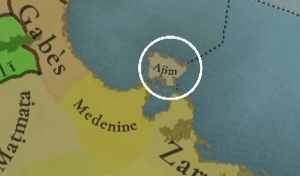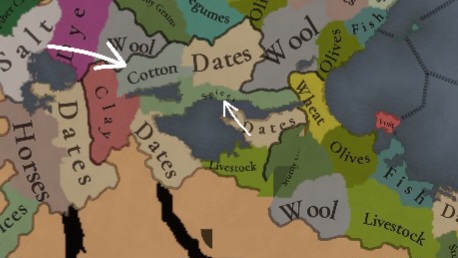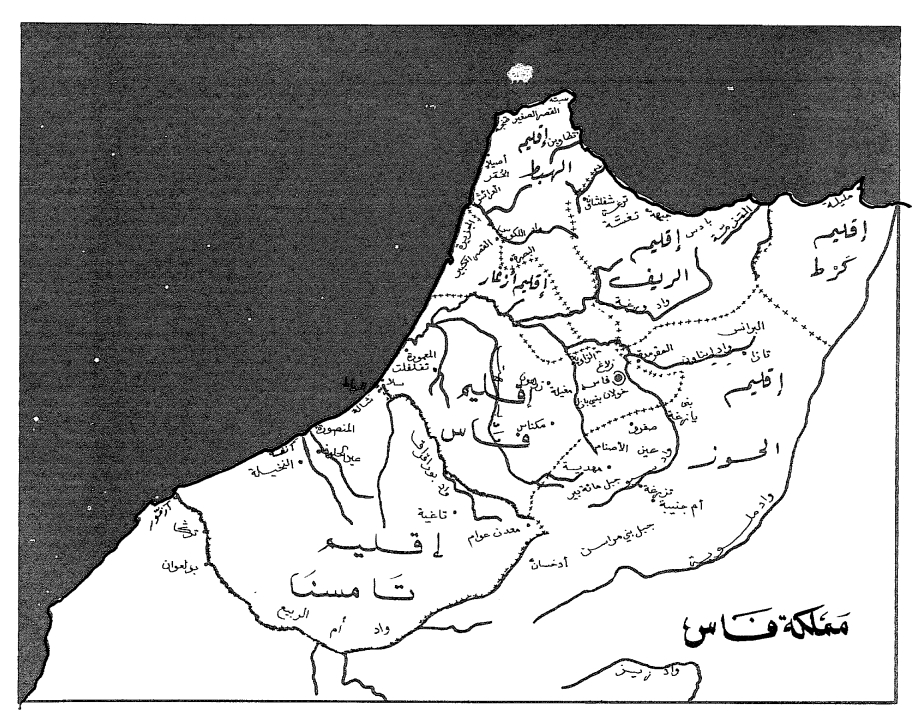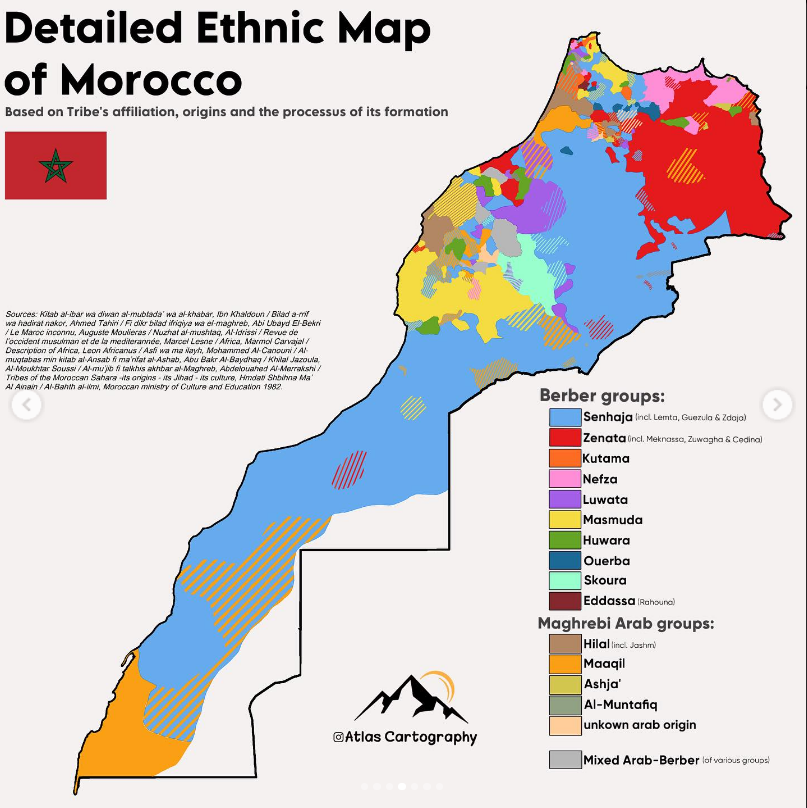Tangier?And piggy backing off of this, and again, up to dev discretion for harbors, but Agadir and Safi (Tit?) could be considered bays as well as Oran (Wehran) and maybe Bijaya, Annabah, and Bizerte. Not great harbors, but it would flesh out the North Africa region quite a bit more.
Tinto Maps #13 Maghreb Feedback
- Thread starter Pavía
- Start date
-
We have updated our Community Code of Conduct. Please read through the new rules for the forum that are an integral part of Paradox Interactive’s User Agreement.
You are using an out of date browser. It may not display this or other websites correctly.
You should upgrade or use an alternative browser.
You should upgrade or use an alternative browser.
Edit: me putting the sources couldn't allow me to post this, so it may seem what I'm saying is nonsense without any source but if anyone can inform me how to bypass this, I can post all the sources.
An interesting source, which, if I'm correct, was made by trusted officials and the people, can be viewed here on the Website.
Tlemcen had a whopping figure of 50,000! Andalusians migrated to it after the fall. Even if the number is exaggerated, Tlemcen has multiple sources describing it as an Andalusian city. Its architecture was almost identical to the Nasrids. Here, an article talks about the 50,000 Andalusians in Tlemcen and how Andalusian Tlemcen was. Multiple sources show many scholars traveling to Granada and describing it as similar to Tlemcen.
Many times, this is shown. Multiple poets and scholars from Tlemcen lived there, and one of the sultans even lived in Granada.
An interesting source, which, if I'm correct, was made by trusted officials and the people, can be viewed here on the Website.
Tlemcen had a whopping figure of 50,000! Andalusians migrated to it after the fall. Even if the number is exaggerated, Tlemcen has multiple sources describing it as an Andalusian city. Its architecture was almost identical to the Nasrids. Here, an article talks about the 50,000 Andalusians in Tlemcen and how Andalusian Tlemcen was. Multiple sources show many scholars traveling to Granada and describing it as similar to Tlemcen.
Many times, this is shown. Multiple poets and scholars from Tlemcen lived there, and one of the sultans even lived in Granada.
- 4
- 1
You will be able to attach links and images when you have a bit more messages on the forum.Edit: me putting the sources couldn't allow me to post this, so it may seem what I'm saying is nonsense without any source but if anyone can inform me how to bypass this, I can post all the sources.
An interesting source, which, if I'm correct, was made by trusted officials and the people, can be viewed here on the Website.
Tlemcen had a whopping figure of 50,000! Andalusians migrated to it after the fall. Even if the number is exaggerated, Tlemcen has multiple sources describing it as an Andalusian city. Its architecture was almost identical to the Nasrids. Here, an article talks about the 50,000 Andalusians in Tlemcen and how Andalusian Tlemcen was. Multiple sources show many scholars traveling to Granada and describing it as similar to Tlemcen.
Many times, this is shown. Multiple poets and scholars from Tlemcen lived there, and one of the sultans even lived in Granada.
- 1
Edit: me putting the sources couldn't allow me to post this, so it may seem what I'm saying is nonsense without any source but if anyone can inform me how to bypass this, I can post all the sources.
An interesting source, which, if I'm correct, was made by trusted officials and the people, can be viewed here on the Website.
Tlemcen had a whopping figure of 50,000! Andalusians migrated to it after the fall. Even if the number is exaggerated, Tlemcen has multiple sources describing it as an Andalusian city. Its architecture was almost identical to the Nasrids. Here, an article talks about the 50,000 Andalusians in Tlemcen and how Andalusian Tlemcen was. Multiple sources show many scholars traveling to Granada and describing it as similar to Tlemcen.
Many times, this is shown. Multiple poets and scholars from Tlemcen lived there, and one of the sultans even lived in Granada.
Well it's a known fact that Tlimsan welcomed a lot of Andalusian refugees as Iberia was lost.
The dialect of the city is influenced by the Andalusi arabic up to this day.
On the other hand, a city like Kairwan was already a pre-hilali arab city and wasn't influenced by their culture.
It really depends and it's a case by case matter.
- 2
Okay! question is there an Andalusian minority in any of the main Maghreb kingdoms, and why are Fez, Tlemcen, and Tunis development kinda low, I expected to be similar to Granada in terms of development. Btw do you think everything I said(if It has a source) would be good enough to add a substantial minortiyYou will be able to attach links and images when you have a bit more messages on the forum.

This place is name djerba not ajim
Ajim is name of area that connects to medenine
"Jerba or Djerba: By the 14th century, the island was commonly referred to as Jerba (or Djerba) in Arabic and European sources. This name has persisted to the present day"
"Jarbah (جربة): In Arabic, the island was (and still is) called Jarbah, which is the name most commonly used in Islamic and Arabic texts from the 14th century onward"
According to Ibn Khaldun - Wikipedia the name comes from one of the bands of Berber tribe Lemaya.
The name Girba was mentioned on an inscription that was discovered during the excavations of the Ghazi Mustapha fort ( a monument in Djerba ) which dates back to the third Century A.D. The name Girba became Djerbah then it became Djerba and remained the name of the island till today.
And it's main produces was and still olive oil introduced in Roman's and phoenicians period its fertile land and also lack of water made it practical to grow quality olive oil and itsCaptil city is Hūmt al-Sūq
(I'm from there)
- 8
- 1
- 1
Also in Djerid

Tozeur didn't produce spices there not even mention of this in any place in tunisia and also madas didn't produce cotton because cotton really needs lot of water to grow and it's hard to have water in desert and there no mention of it by sources
tozeur Produced salt because you know because Chott el-Jerid was the one largest salt pans in the Sahara and today is considered major export of my country (but btw you and me French really control it)
madas produced wool not exactly sure the location produced it but in Djerid definitely it because wool handcraftes were traded locally and sold to caravans and they still sell it to tourist to this day
One last thing speaking in general of map of maghreb why does cotton exists in arid location doesn't it need water to grow I get it in the north but cotton in the desert that doesn't sound realistic even impossible I suggest replacing at least inland cotton with wool because berbers and bedouin in general tended to raise sheep or camel's but wool abstract the tow good

Tozeur didn't produce spices there not even mention of this in any place in tunisia and also madas didn't produce cotton because cotton really needs lot of water to grow and it's hard to have water in desert and there no mention of it by sources
tozeur Produced salt because you know because Chott el-Jerid was the one largest salt pans in the Sahara and today is considered major export of my country (but btw you and me French really control it)
madas produced wool not exactly sure the location produced it but in Djerid definitely it because wool handcraftes were traded locally and sold to caravans and they still sell it to tourist to this day
One last thing speaking in general of map of maghreb why does cotton exists in arid location doesn't it need water to grow I get it in the north but cotton in the desert that doesn't sound realistic even impossible I suggest replacing at least inland cotton with wool because berbers and bedouin in general tended to raise sheep or camel's but wool abstract the tow good
- 5
- 1
There has not been given any reason apart from some sound similarity that justifies the change of name. I am well aware that Chaus is clearly a transcription from the arabic sound. However, Chaus, while imperfect, is well documented in more than one source.I have to say I'm disappointed the Chaus province wasn't renamed to (el-) Haouz.
Haouz region is not even close to the geographical place represented by Chaus (they are in different sides of the Atlas) so it is not likely that they are the same place.
- 5
- 1
Can I ask what word Chaus is based on? The reason I said this was because I thought it was taken from a map (attached) which labeled the region الحوز /lħawz/, and that Chaus was a confusing and inconsistent way to write that. With this spelling, it looks like it should be pronounced /ʃaws/ and be written شوس in Arabic. If it refers to another name entirely from الحوز, I will retract my comment.There has not been given any reason apart from some sound similarity that justifies the change of name. I am well aware that Chaus is clearly a transcription from the arabic sound. However, Chaus, while imperfect, is well documented in more than one source.
Haouz region is not even close to the geographical place represented by Chaus (they are in different sides of the Atlas) so it is not likely that they are the same place.

الحوز on this map is not anywhere near the modern el Haouz, true, but I assumed it was your basis for calling it Chaus because the other provinces with obscure names also fit (Habat, Kert, Azghar). And I hadn't heard of "Chaus" anywhere else. It is not the same place as modern Haouz, but it appears they had the same name.
If it is based on that and you guys want to stick with it anyways despite the inconsistent spelling just because it's more common, so be it, it's not the end of the world.
Last edited:
- 2
Ok, for what I see there was a miscomunication.Can I ask what word Chaus is based on? The reason I said this was because I thought it was taken from a map (attached) which labeled the region الحوز /lħawz/, and that Chaus was a confusing and inconsistent way to write that. With this spelling, it looks like it should be pronounced /ʃaws/ and be written شوس in Arabic. If it refers to another name entirely from الحوز, I will retract my comment.
View attachment 1260499
الحوز on this map is not anywhere near the modern el Haouz, true, but I assumed it was your basis for calling it Chaus because the other provinces with obscure names also fit (Habat, Kert, Azghar). And I hadn't heard of "Chaus" anywhere else. It is not the same place as modern Haouz, but it appears they had the same name.
If it is based on that and you guys want to stick with it anyways despite the inconsistent spelling just because it's more common, so be it, it's not the end of the world.
My source was a map in roman alphabet, which means that I never had the original and I just noted that I was aware that, because of that, the transcription could be perfectly wrong.
This means that I have/had no idea how it was written in arabic, so that made trying to transcript it more faithfully impossible.
If you add to this that there is a Haouz region that is nowhere close to this, it seemed to me unlikely that the "Chaus" region would be Haouz too.
As you are one of those people in this forum that I have read several times and know things about you, I remember that you spoke arabic. So in this case I think, with this map strengthing your claim, that you were right all along.
THis means that on Monday I will update the name of this province to Haouz. Can you tell me how it would be this in latin alphabet with the proper diacritics? I think we are going to use the ISO rule for arabic but we are still debating it. Still it would be rather close either way.
- 8
- 1
Thanks for the reply. I just wanted you to be as informed as possible. I believe the proper ISO transliteration would be Al-Ḥawz. El Haouz (or El Ḥaouz, with the proper diacritic) would be a more local-looking alternative that would fit with most of the spellings you have elsewhere in the Maghreb right now, though it would risk confusion with the modern Haouz. It's your choice, depending on style.Ok, for what I see there was a miscomunication.
My source was a map in roman alphabet, which means that I never had the original and I just noted that I was aware that, because of that, the transcription could be perfectly wrong.
This means that I have/had no idea how it was written in arabic, so that made trying to transcript it more faithfully impossible.
If you add to this that there is a Haouz region that is nowhere close to this, it seemed to me unlikely that the "Chaus" region would be Haouz too.
As you are one of those people in this forum that I have read several times and know things about you, I remember that you spoke arabic. So in this case I think, with this map strengthing your claim, that you were right all along.
THis means that on Monday I will update the name of this province to Haouz. Can you tell me how it would be this in latin alphabet with the proper diacritics? I think we are going to use the ISO rule for arabic but we are still debating it. Still it would be rather close either way.
Honestly, you guys could even keep it as Chaus if you feel that is historically accurate, it's just that it'd use a totally different pronunciation system from pretty much every other Arabic placename in the game. It looks like how a Dutchman or maybe German would spell it, while right now the vast majority of Arabic placenames are a mix of modern academic transcriptions and French and English-aligned orthography.
By the way, according to that map Habat should also receive the Al- prefix, but that's of minor importance. There are also a few diacritics to add in the other province names, if you want to be consistent.
Last edited:
- 6
When I reviewed the Maghreb map I tried to change all the names to English (wikipedia standard) as a base and localized as many as I could in dynamic arabic localisation using Modern Standard Arabic (and in some cases the DIN rule as it is the closest), trying to homogeneize them all. We are aware that despite this effort, there are still some inconsistencies and we plan to further standardize it in the future, however, it is not trivial so we would like to as you all to not report this things for a while as we are aware of them being improvable.Thanks for the reply. I just wanted you to be as informed as possible. I believe the proper ISO transliteration would be Al-Ḥawz. El Haouz (or El Ḥaouz, with the proper diacritic) would be a more local-looking alternative that would fit with most of the spellings you have elsewhere in the Maghreb right now, though it would risk confusion with the modern Haouz. It's your choice, depending on style.
Honestly, you guys could even keep it as Chaus if you feel that is historically accurate, it's just that it'd use a totally different pronunciation system from pretty much every other Arabic placename in the game. It looks like how a Dutchman or maybe German would spell it, while right now the vast majority of Arabic placenames are a mix of modern academic transcriptions and French and English-aligned orthography.
By the way, according to that map Habat should also receive the Al- prefix, but that's of minor importance. There are also a few diacritics to add in the other province names, if you want to be consistent.
I am going to definitely change Chaus to Al-Ḥawz as we want to get things the most standardized as possible (yes, again, we are aware that there are inconsistencies to this rule across the map, but again it is not as easy as it seems and we are doing it in iterations, so this is an ever-going effort).
- 8
- 3
I've looked a bit into it and I'd say that Touat, Djerid, Touggourt Ouargla and Fezzan should have the tribe government rather than monarchy, as unlike other tags like Tripoli(who is also technically ruled by a tribe) these rulers didn't act like reginal governors for the sultans but are just semi-nomadic vassals/tributaries living around oasis mainly as herdersTribe? Did Mzab and the other tags nearby really have the same institutions as Tunis?
Last edited:
- 4

The map is a bit controversial, yes, but no less than tinto's culture map to be honest, and more precise and I believe more accurate in terms of tribal affiliation.
Anyways, from examining this map:
- The Sanhaja pops in the Dukkala province should be changed to Masmuda.
- Within the Tamasna province, Azamur should be mixed Sanhaja-Masmuda, Anfa should be Zenata, and Sattat should be a mix of Masmuda, Arab and Zenata.
- The Arab population in the vicinity of Sous is seemingly in the wrong place, it should be removed and instead a significant Arab minority should be added to Tarudant and Igiliz locations.
- The southern halves of the Sus and Guzzula provinces should be Sanhaja, not Masmuda.
- We should consider making Sala (Sale) majority Arab.
- Amazigh are severely underrepresented in Western/Moroccan Sahara, though the exact distribution on this map might be unreliable given that it depicts a post-Char Bouba reality.
- It looks like Ameskur should be Zenati, not Sanhaja.
- As I mentioned previously, Azilal, Ayt Dawud, Midalt, Tednest and Afsu being majority Arab, especially without significant minorities, is quite doubtful unless there are strong sources for it as they are all deep within Amazigh areas and I see no Arab tribes corresponding to them. Honestly looks like a possible pop editor error to me.
- Not commenting on the makeup of Mugadur (modern Essaouira), as whether those tribes are Arab or Amazigh is most likely one of the most controversial parts of this map, and we should remember that this vicinity had been subject to Arab migrations under the Almohads.
- 1
I will point out that arab settlement did continue during the marinid dinasty and so did internal migrations, but that map is closer to the 1337 reality than the current one.View attachment 1275234
The map is a bit controversial, yes, but no less than tinto's culture map to be honest, and more precise and I believe more accurate in terms of tribal affiliation.
Anyways, from examining this map:
- The Sanhaja pops in the Dukkala province should be changed to Masmuda.
- Within the Tamasna province, Azamur should be mixed Sanhaja-Masmuda, Anfa should be Zenata, and Sattat should be a mix of Masmuda, Arab and Zenata.
- The Arab population in the vicinity of Sous is seemingly in the wrong place, it should be removed and instead a significant Arab minority should be added to Tarudant and Igiliz locations.
- The southern halves of the Sus and Guzzula provinces should be Sanhaja, not Masmuda.
- We should consider making Sala (Sale) majority Arab.
- Amazigh are severely underrepresented in Western/Moroccan Sahara, though the exact distribution on this map might be unreliable given that it depicts a post-Char Bouba reality.
- It looks like Ameskur should be Zenati, not Sanhaja.
- As I mentioned previously, Azilal, Ayt Dawud, Midalt, Tednest and Afsu being majority Arab, especially without significant minorities, is quite doubtful unless there are strong sources for it as they are all deep within Amazigh areas and I see no Arab tribes corresponding to them. Honestly looks like a possible pop editor error to me.
- Not commenting on the makeup of Mugadur (modern Essaouira), as whether those tribes are Arab or Amazigh is most likely one of the most controversial parts of this map, and we should remember that this vicinity had been subject to Arab migrations under the Almohads.
- 2
Yes of course, alongside assimilation, though AFAIK the major wave of Arab immigration happened under the Almohads. The map is portraying tribal origins, not current ethnolinguistic affiliation regardless of origins. If the latter were the case, of course Morocco would be shown as majority Arab as I'm sure you know.I will point out that arab settlement did continue during the marinid dinasty and so did internal migrations, but that map is closer to the 1337 reality than the current one.
- 1
I request that it be kept as it was, because otherwise it just makes things more complicated (especially given that ğ is also a letter in their alphabet).No, it's a letter of its own used in Tamazight languages: https://en.wikipedia.org/wiki/Voiced_velar_fricative
Although we're currently evaluating changing it for a ğ, as it could be a better compromise between linguistical accuracy and in-game readability:
View attachment 1240738
As someone who loves doing phonetic transliteration into whatever language of my conquering country, I would rather keep the representation being something I can easily cross-reference rather than something bespoke.
To be honest I don't see why it should be anything other than however they're transliterating غ, it's the same sound.I request that it be kept as it was, because otherwise it just makes things more complicated (especially given that ğ is also a letter in their alphabet).
As someone who loves doing phonetic transliteration into whatever language of my conquering country, I would rather keep the representation being something I can easily cross-reference rather than something bespoke.

